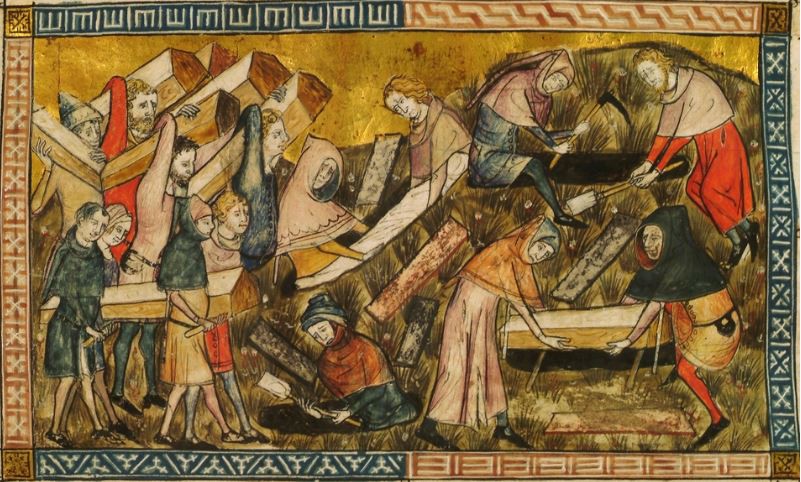Pandemic, probably the most written word of the past year. This word has taken over our lives, but how has history dealt with pandemics? What was the most deadly disease that ever existed? Let’s tell you some more about it.
There are a couple of quite lethal diseases like smallpox and SARS¹, the bird flu was also a substantial one, but one really stood out: the Bubonic Plague².
What Kind of Disease Is the Bubonic Plague?
The Bubonic Plague is a type of disease caused by the plague bacterium³, a biological cell. This plague will develop flu-like symptoms within seven days after infection. These symptoms could be headaches, fevers, swollen lymph nodes. The swollen nodes usually break open, which causes a lot of pain.
The Bubonic Plague is very deadly; without treatment, less than 40% of infected people survive it. Most deaths occur between the third and fifth day after the first symptoms.
Gangrene due to damage to the end arteries (limbs and nose) is common. This often results in the amputation of fingers, toes, or larger parts of the arms or legs.
The spread of this disease can be prevented mostly by not handling dead animals, and if you thought there is a working vaccine for this disease already, you’re wrong because most vaccines don’t work for these types of plagues.
When Did the Bubonic Plague Strike the World?
Between 541 and 549, the first major plague pandemic broke out. It was called the Plague of Justinian⁴, a very contagious disease, mainly spread by animals. This plague was named after Emperor Justinian⁵.
This emperor was infected but was treated very heavily and managed to survived, which is remarkable knowing that the mortality rate is around 50%.
This pandemic alone⁶ caused around 25 to 50 million deaths.
This plague was initiated in the Sassanian Empire, and after only one year, the disease reached Constantinople, where it went from port to port and infected the whole Mediterranean area.
There are even claims that the Emperor created this plague himself and that he would be so cruel that he wanted to kill his whole empire.
Around 549, the plague would have been finished with its killing and spreading.
Then, in the late middle ages, a second pandemic came around. This time, all of Europe was hit. In 1347, this Bubonic Plague would kill around one-third of the European population.
The Bubonic Plague created chaos and death by massive infection and mortality rates, also causing a lot of violence in the European streets. People were robbed or killed.
It was thought that this plague had originated in Central Asia and then spread throughout Europe. Mongolia was also showing a lot of deaths in that period of time.
When the Mongols cut off the trading routes⁷, the spread of the plague was halted. The disease spread by fleas on rats onboard trading ships and that’s how it reached the European mainland.
The last time this type of plague caused an actual pandemic was in the mid 19th century, having also originated from the East of Asia.
At the beginning of 1894, the disease started spreading and killing, and around June of that year, it had killed around 80.000 people⁸.
This pandemic took more than 12 million lives in China and India alone and spread across all inhabited continents. The third pandemic was officially declared by the WHO (World Health Organization) in 1959 when only 200 cases were reported worldwide.
The Aftermath of the Pandemics
In the aftermath of the pandemic of the 19th century, there were two more epidemics of pneumonia in Manchuria in the early 20th century, with the outbreak of 1910/1911 still killing 60,000 people.
The epidemic was the result of a 400% increase in the price of marmot fur. These pelts were used as a substitute for sable fur. The experienced hunters did not hunt sick animals, and eating the fat from the armpits was taboo.
The rise in fur prices attracted a mass of inexperienced Chinese hunters, who also caught the sick animals and for whom the armpit fat was a delicacy.
The disease spread from the hunting grounds to the terminus of the Trans-Manchurian Railway and from there followed the track for a distance of 2,700 km. The epidemic lasted seven months.
The last major outbreak associated with the third pandemic occurred in Peru and Argentina in 1945 and was averted by massive DDT spraying. Since then, there have been major outbreaks in Africa, Indonesia, South America, and Vietnam.
In World War II, the Japanese military used the plague as a biological weapon. In Manchuria, civilians and prisoners of war were deliberately infected with the disease. The effects were studied, and the victims were sometimes dissected conscious.
Infected fleas were also spread among the Chinese. Ultimately, this would cause approximately 200,000 Chinese to die of the disease.
Is the Bubonic Plague Still Around?
Yes, the Bubonic Plague is still among us. For example, in Idaho, a child was infected with this disease.⁹
This shows us that these diseases still exist, but fortunately, the plague can be cured with modern pharmaceutical techniques.
Although there aren’t many known cases of this type of plague, with an average of 15 per year in the US, it is mostly seen in Africa, and it can still kill.
Originally Published on Medium by me (Bryan Dijkhuizen)
References.
6. https://openlibrary.org/books/OL22754520M/Justinian%27s_flea
8. https://hkjo.lib.hku.hk/archive/files/45de276ec2338bbab18a7bbb35a4d1de.pdf
9. https://abcnews.go.com/Health/plague-exists-now-us/story?id=55860883



